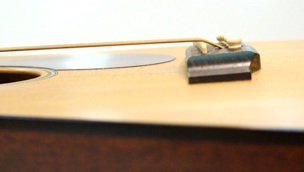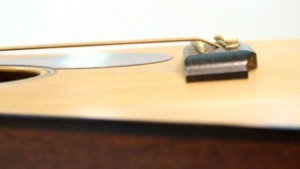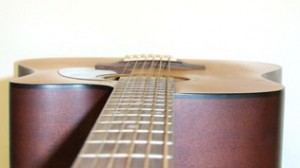Martin Guitars Humidity & Temperature Recommendations:
Your guitar is made of thin wood which is easily affected by temperature and humidity. This combination is the most important single part of your guitar’s surroundings. Martin keeps the factory at a constant 45-55 percent humidity and 72-77 degrees Fahrenheit. If either humidity or temperature get far away from these factory conditions, your guitar is in danger. A rapid change in temperature or exposure to cold can cause small cracks in the finish. These are lacquer checks. We recommend the use of a hygrometer/ thermometer to measure the relative humidity and temperature surrounding your guitar.
As humidity increases, moisture content of wood goes up rapidly, causing it to expand and swell. A gradual increase in humidity won’t generally do permanent damage to your instrument. When very high humidity is combined with high temperature, glue joints could possibly become weakened and may even open slightly. If your guitar is exposed to high temperature or humidity for any length of time, the glue under the bridge could weaken causing the bridge to pull off.
Rapid changes in local humidity are what you want to guard against. If, for instance, you place your guitar near a source of dry heat, the humidity around it will drop much faster than it would naturally, although a sudden dry spell can have the same effect. If the moisture content of wood is forced down in a hurry, portions of it shrink faster than others, causing cracks and open joints. Don’t set your instrument next to a source of heat or hang it on a wall where it will dry out. At all costs, avoid hanging your guitar on an outside wall during winter months. The wall will be cooler than the inside air. The result is a conflict between the temperature of the top and back, with potential damage as a result.
Should the guitar be exposed to freezing temperatures, let it warm to room temperature while still in its case. This lets it come up to room temperature more slowly, decreasing the possibility of wood and finish cracks.
Caution should be taken if you choose to use a humidifier to combat low humidity. Moisture in direct contact with the guitar could cause damage, as can the rubber or vinyl parts of a humidifier.
Pro Music Humidity & Temperature Recommendations:
The top of the guitar needs to be looked at regularly. You sight across the top of the guitar between the sound hole and the bridge. If the top is sinking in, then the guitar is dehydrated and more moisture is needed (see pictures above). If the top is above level, then the guitar is over hydrated and a dehumidifier is needed. An example of a dehumidifier is the desiccant packets that usually ship with electronic equipment. Some examples of various humidifiers are sound hole humidifiers, tube humidifiers, and case humidifiers. These humidifiers are designed to maintain humidity only. If severe dehydration has already occurred, then more advanced methods of re-hydration might be necessary.
In the interior of Alaska, the arctic climate can be dryer than a desert. One humidifier may not be enough to keep the humidity at 50%. Sometimes two or more humidifiers are need; especially in homes that heat with wood stoves.
Temperatures in Alaska can reach -50ºF regularly in the winter months. Rapid changes in temperature must be avoided to protect guitar finishes.


